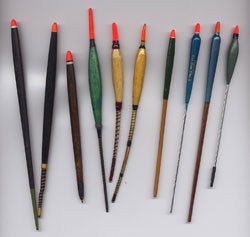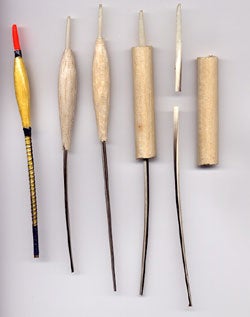| To conclude this short series I’m going to look in more detail at the floats suitable for fishing on rivers. The Avon Float The Avon was, it’s claimed, designed for fishing the deep waters of the Warwickshire Avon. In its original form it had a long cork body on a stem of crow quill. Since then it has evolved to use balsa or Styrofoam for the body. Crow quill remains the best stem material though it is fragile. The Avon float is THE float for presenting bread (especially punch) over groundbait on a river in swims of even flow and depth. Always attach the float with three rubbers, top, below the body and one tight one about an inch long at the base. Let a bit of the base rubber protrude past the end and don’t put a shot underneath the float. Use BB, AB, an olivette or BB tube shot stopped with no 8 for the bulk. My preference is to have the bulk between two and three feet from the hook, depending on the depth and flow with either two no 8s bulked about a foot from the hook as a starting point, or with a second mini bulk of three or four no 8s just above the hook link with the bulk shot a foot higher. For fishing at range most of the tip should be left showing but in slow water and fishing close in it can be advantageous to shot the float right down to just an eighth of an inch showing. The Avon will work in water over ten feet deep.
The difficulty in obtaining good Avon floats depends upon where you live; here in Dorset the tackle shops stock a good range of true Avons made with crow quills though I prefer to make my own. Avoid those made with cane stems if at all possible. A range of 4BB, 5BB, 6BB, 8BB, 10BB will cover 90% of the situations that require an Avon. The Balsa Balsa floats became popular in the 60’s, partly due to the success of Peter Drennan. The balsa comes into its own for fishing flake with mashed bread with a spread shotting pattern up to a moderate depth of say eight feet. The thicker tip resists the current’s tugs and pulls on the bait. One shotting pattern that I have used a lot consists of two-thirds bulk then one or two smaller bunches then a dropper, spread to cast well. Use a float with a finer tip for fishing maggots. The balsa tends to be less splashy than an Avon on the strike but trickier to hold back as the shoulder is less pronounced, although this can overcome with practice and careful shotting. You should have more luck obtaining balsa floats than Avon. A similar range to that of the Avons is a good starting point. The Stick float Next we have the stick float, which was, for many years, the match anglers’ favourite. This is the most specialist float of all the trotting floats. Use it wrongly and you are surely wasting your time, but get it right and you have a devastating weapon. Although its role is increasing when using a pole there remains a valid place for the stick, both in matches and pleasure fishing. It is more than mere co-incidence that first class ranges of stick floats have been developed and marketed under the name of top class match anglers. Benny and Kevin Ashurst, Ivan Marks, Pete Warren, John Dean, John Allerton and Dave Harrell have all put their name to excellent commercially produced sticks. Dig a bit deeper and you will find that the stick floats that they have used themselves have been the one-off homemade specials. That said, examples of those mentioned are excellent if you can find them. The traditional cane stick is rarely used nowadays although, in the right hands, a Pete Warren style float with a dome top is deadly.
The next type of stick is the alloy stem popularised by John Allerton. This brilliant angler designed these floats to beat tricky swims on the Trent with its downstream winds and sometime boily water. These do not cast quite as well as the floats described above but will ride the water superbly. I use these versatile floats in a variety of conditions from shallow fast water to deep water, especially using small baits such as maggot and caster rather than bread. The smaller models work best in shallow water with a load of 4 no 4 being adequate. The old guideline of about one no 6 shot for each foot of depth, increasing to a no 4 for more powerful flows, is a good starting point. The Allerton Mark 1 model went up to a maximum of 8 no 4, but if you want a larger model MAP produce floats taking up to 14 no 4. Alternatively make your own. I suspect that some of the floats made by John Allerton himself cast better than the commercial models, certainly he is one of the most gifted anglers with a stick float. These floats are easy to hold back with their wide shoulder, and therefore overshotting works well at close range.
Stick floats available nowadays include Drennan, Dick Clegg, MAP (Dave Harrell), and Middy. The final type of rod and reel floats that are used top and bottom are those designed for using with long rods. These have evolved from pole floats, and it is not difficult to take a big pole float (taking from 2 grams upwards) with a carbon stem and modify it by replacing the antenna with a thicker tip to form a suitable float. Dave Harrell has designed his alloy Avons with a similar use in mind. The end result of this is long-range pole fishing but with a running line where some of the precision linked with a pole is sacrificed for the versatility and range of a running line. These floats are usually fished with some form of bulk, especially an olivette, with a series of droppers underneath. More conventional floats can, of course, be used with these long rods. Wagglers As mentioned earlier, for beginning to learn waggler fishing a small selection of unloaded, unbodied peacock wagglers with total shot capacities of between 2AAA and 4AAA should suffice. Get some with thickish inserts and some without inserts. Initially at least, look for wagglers around 9-10 inches long. There is a place for very short wagglers, especially for shallow water, and similarly for very long floats but for the time being keep it straightforward. Also, you will need some float adapters to attach the floats. Look for floats by MAP, Drake, Drennan and Kamasan. Conclusion The whole area of trotting on rivers is vast. There are some very specialist skills for fishing at long range, on shallow water, in very fast water and in very windy conditions. Master the basics before attempting the difficult stuff. There is a wealth of books and videos that explain the basics, as well as Dave Cooper’s articles on FM. Try your local library for books by Ivan Marks, John Wilson, Matt Hayes, John Bailey, Dave King and Alan Haines. Happy Trotting! |
Welcome!Log into your account













